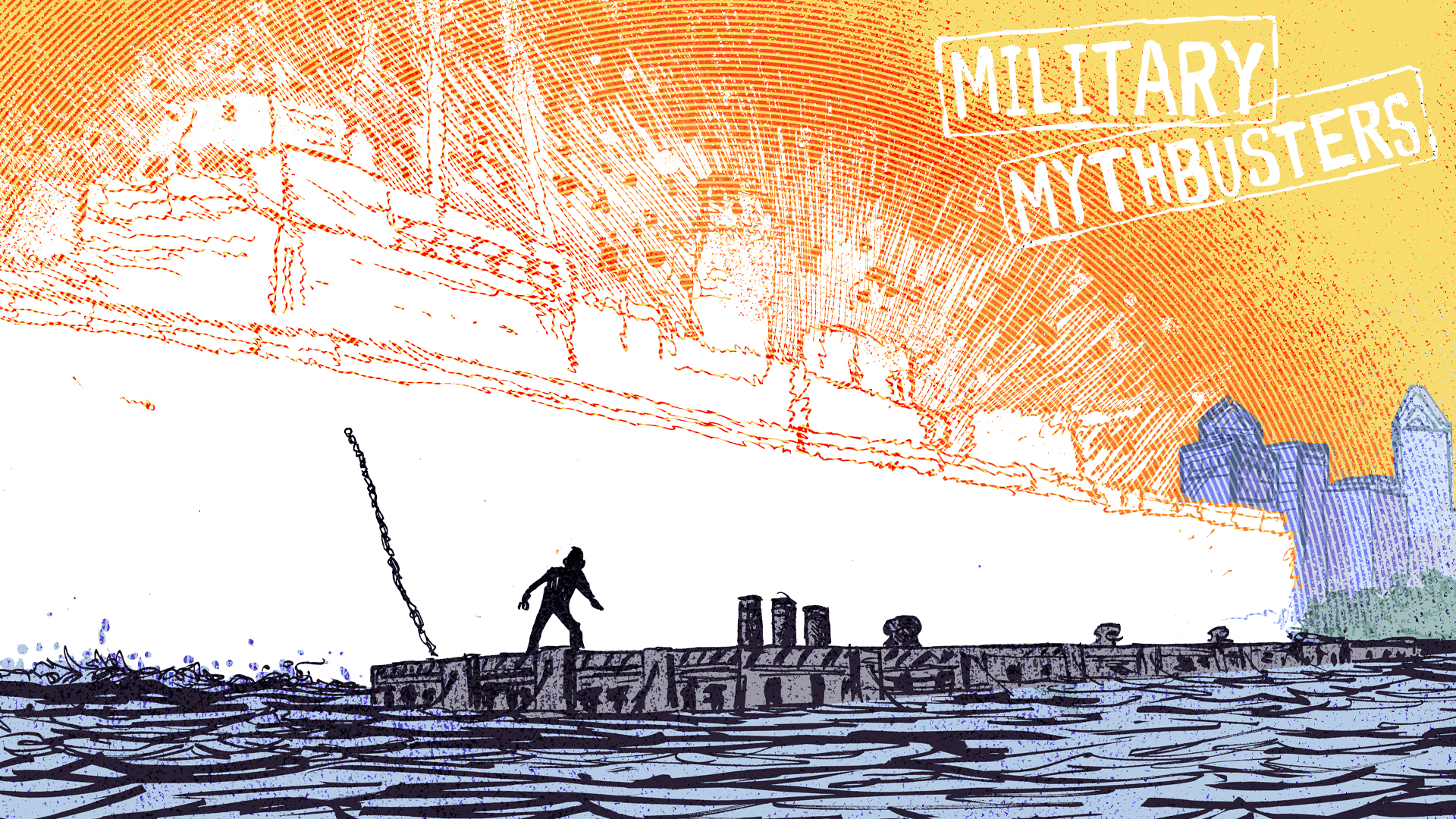The story goes like this: During World War II, the Navy was experimenting with making a cannon-class destroyer escort invisible.
The tale focuses on two occasions: Once, the USS Eldridge was rendered invisible, leaving behind only a cloud of green fog; in another instance, the Eldridge was teleported from Pennsylvania to Virginia and back again, and 10 seconds back in time. On both occasions, the crew suffered extreme side effects, including nausea, being fused to internal structures of the ship, going insane, and even vanishing.
It was known as the Philadelphia Experiment. And as you might have guessed, it never happened.
The myth has gone on to be retold in various books and movies over the years, including the 1984 film, “The Philadelphia Experiment,” which tells the story of two sailors who are transported in time from 1943 to 1984 through the disappearing-destroyer experiment. It has even been addressed by the Navy’s Office of Naval Research, who disputed that such a thing ever happened.
“Allegedly, in the fall of 1943 a U.S. Navy destroyer was made invisible and teleported from Philadelphia, Pennsylvania, to Norfolk, Virginia, in an incident known as the Philadelphia Experiment,” the Naval History and Heritage Command website says. “Records in the Archives Branch of the Naval History and Heritage Command have been repeatedly searched, but no documents have been located which confirm the event, or any interest by the Navy in attempting such an achievement.”

Subscribe to Task & Purpose Today. Get the latest in military news, entertainment, and gear in your inbox daily.
The origins of the urban legend were traced back to 1955, when a book titled The Case for UFOs was published by Morris K. Jessup, according to the Navy’s Office of Naval Research. A man who read Jessup’s book, Carl M. Allen, who also signed his letters as Carlos Miguel Allende, wrote to Jessup with his thoughts on the book and shared “details of an alleged secret naval experiment” conducted by the Navy in 1943. Allen had allegedly been aboard a civilian merchant ship, the SS Andrew Furuseth, when he and other crew members saw the Eldridge teleport to Norfolk.
Allen claimed to have “first-hand knowledge” of the experiments, according to a 1994 article in the Journal of Scientific Exploration written by Jacques Vallee. Jessup “was troubled” by Allen’s claims, but Allen couldn’t provide evidence beyond a list of names of other sailors who had been aboard the Furuseth.
A re-telling from Gizmodo says that the first experiment took place in July 1943, when an “alleged method of electrical field manipulation” turned the USS Eldridge invisible in Philadelphia. The second experiment resulted in the Eldridge teleporting to Norfolk, Virginia, on October 28, 1943, and traveling a few seconds back in time, before returning to Philadelphia.
Sailors who had been on the ship “were said to have been affected … to such an extent that some went insane, others developed mysterious illnesses,” Vallee wrote. Two sailors later allegedly vanished from a bar in a way that left their waitress “terrified and confused.”
There was even speculation that during the experiment, the U.S. military “was able to contact alien entities” and “established cooperation,” wrote Vallee. Allen even told Jessup in his letters that the incident had been reported by a Philadelphia newspaper, though no evidence of such an article has been found.

As you might expect, what really happened is not nearly as creepy or mysterious. The myth likely originated from “routine research” at the Philadelphia Naval Shipyard during World War II. One possible explanation from the Navy is that military personnel were experimenting with ways to make ships “invisible” to sensors of magnetic mines. Another explanation could be that in the 1950s, another ship — the USS Timmerman — was experimented on to test “the effects of a small, high-frequency generator.”
The Navy has also said that the Eldridge was not commissioned until August 1943, and for the rest of the year was never in Philadelphia. Additionally, official records show that the Furuseth was never in Norfolk at the same time as the Eldridge. The captain of the Furuseth also said in a letter in the Navy’s archives that neither he nor his crew ever “observed any unusual event while in Norfolk,” according to the Navy.
Vallee’s article in the Journal of Scientific Exploration describes Allen as a mysterious figure and outcast who others identified as a drifter and generally odd person. And while he “did win the mind of Morris Jessup,” reads the 2012 Gizmodo article, Jessup died just four years later “from an apparent suicide.”

While Allen’s letters to Jessup “strongly and repeatedly suggested” that there was evidence of the experiment, and said it could be found in witness testimonies and ship logs, “it was always just beyond the reach of independent investigators,” Vallee wrote.
Ultimately, the Office of Naval Research “has never conducted any investigations on invisibility, either in 1943 or at any other time,” the Navy said. And scientists within the office “do not believe that such an experiment could be possible except in the realm of science fiction.”
But then again, isn’t that exactly what they’d want us to think?
The latest on Task & Purpose
- Russian troops are proving that cell phones in war zones are a very bad idea
- Air Force disciplines C-130 crew for ‘unplanned’ landing to pick up motorcycle in Martha’s Vineyard
- Commandant walks back possibility of Marines skipping boot camp
- Air Force pilots explain why the F-22 Raptor is a ‘beast’ in aerial combat
- Sailors from my old ship are dying by suicide. I may know why
Want to write for Task & Purpose? Click here. Or check out the latest stories on our homepage.

